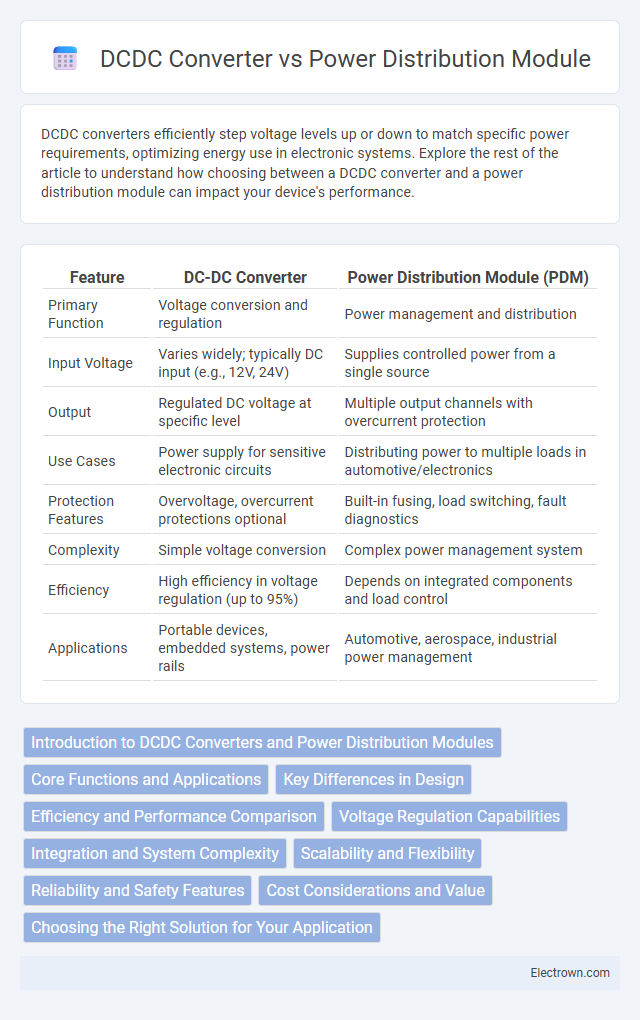DCDC converters efficiently step voltage levels up or down to match specific power requirements, optimizing energy use in electronic systems. Explore the rest of the article to understand how choosing between a DCDC converter and a power distribution module can impact your device's performance.
Table of Comparison
| Feature | DC-DC Converter | Power Distribution Module (PDM) |
|---|---|---|
| Primary Function | Voltage conversion and regulation | Power management and distribution |
| Input Voltage | Varies widely; typically DC input (e.g., 12V, 24V) | Supplies controlled power from a single source |
| Output | Regulated DC voltage at specific level | Multiple output channels with overcurrent protection |
| Use Cases | Power supply for sensitive electronic circuits | Distributing power to multiple loads in automotive/electronics |
| Protection Features | Overvoltage, overcurrent protections optional | Built-in fusing, load switching, fault diagnostics |
| Complexity | Simple voltage conversion | Complex power management system |
| Efficiency | High efficiency in voltage regulation (up to 95%) | Depends on integrated components and load control |
| Applications | Portable devices, embedded systems, power rails | Automotive, aerospace, industrial power management |
Introduction to DCDC Converters and Power Distribution Modules
DCDC converters efficiently transform voltage levels to match specific power requirements, ensuring stable and optimized energy supply within electronic systems. Power distribution modules manage and allocate electrical power to multiple subsystems, enhancing system reliability and simplifying wiring complexity. Your choice between these components depends on whether voltage conversion or power management is the primary need in your application.
Core Functions and Applications
DCDC converters regulate voltage levels by stepping up or stepping down DC voltage to ensure efficient power supply to electronic components, primarily used in battery-powered devices, automotive systems, and renewable energy applications. Power distribution modules manage and distribute electrical power from a single source to multiple outputs, integrating circuit protection and monitoring features essential in complex systems like automotive electrical networks and industrial machinery. Both components optimize energy management but serve distinct roles: DCDC converters focus on voltage conversion, while power distribution modules prioritize power routing and safety.
Key Differences in Design
DCDC converters primarily focus on voltage regulation by converting input power to a stable output voltage, using inductors, capacitors, and switching elements to optimize efficiency and minimize noise. Power distribution modules integrate multiple power management functions, including DCDC conversion, fusing, and load switching, enabling streamlined power delivery and system protection within a single unit. The key design difference lies in the specialized voltage transformation role of DCDC converters versus the comprehensive power routing and protection capabilities of power distribution modules.
Efficiency and Performance Comparison
DCDC converters typically offer higher efficiency by precisely regulating voltage conversion with minimal energy loss, often achieving efficiencies above 90%. Power distribution modules integrate multiple functions such as circuit protection and power management but may introduce slightly higher resistance and heat generation, reducing overall efficiency compared to standalone DCDC converters. Your choice depends on whether optimized voltage regulation or integrated system functionality is more critical for your application's performance.
Voltage Regulation Capabilities
DCDC converters provide precise voltage regulation through high-frequency switching that maintains stable output voltage despite input fluctuations or load changes, ensuring efficient power delivery. Power distribution modules (PDMs) primarily distribute power rather than regulate voltage, often relying on integrated or external DCDC converters for voltage management. DCDC converters are essential within PDM systems to achieve consistent voltage levels for sensitive electronics.
Integration and System Complexity
DCDC converters offer high integration by combining voltage conversion and regulation within a compact form, reducing the need for multiple discrete components. Power distribution modules, while integrating protection and distribution functions, often add complexity due to managing multiple output channels and system-level controls. Your choice depends on whether minimizing system complexity through single-function integration or managing multiple power paths efficiently is a higher priority.
Scalability and Flexibility
DCDC converters offer high scalability by efficiently stepping voltage levels in modular power systems, facilitating easy integration and expansion without major redesign. Power distribution modules provide enhanced flexibility through configurable outputs and integrated protection features, allowing tailored power delivery to multiple loads within complex systems. Combining DCDC converters with power distribution modules ensures optimized scalability and adaptability in evolving electrical architectures.
Reliability and Safety Features
DC-DC converters offer high reliability due to their efficient voltage regulation and built-in protection features such as overcurrent, short-circuit, and thermal shutdown safeguards. Power distribution modules enhance system safety by integrating multiple protection layers, including fuses, circuit breakers, and fault monitoring, ensuring robust power management across complex electrical architectures. Both devices contribute to system stability, but power distribution modules provide a comprehensive safety approach for multi-load environments.
Cost Considerations and Value
DCDC converters generally offer a more cost-effective solution for voltage regulation in specific applications due to their simplicity and higher efficiency. Power distribution modules, while typically more expensive upfront, provide enhanced value by integrating multiple functions such as monitoring, protection, and load management, reducing overall system complexity and maintenance costs. Your choice should weigh initial investment against long-term benefits, considering application requirements and total cost of ownership.
Choosing the Right Solution for Your Application
Choosing between a DCDC converter and a power distribution module depends on the specific voltage regulation and power management needs of your application. DCDC converters efficiently step up or step down voltage levels, ideal for applications requiring precise voltage control with high efficiency. Power distribution modules simplify power management by integrating multiple outputs and protections, suitable for complex systems needing centralized power control and safety features.
DCDC converter vs Power distribution module Infographic

 electrown.com
electrown.com